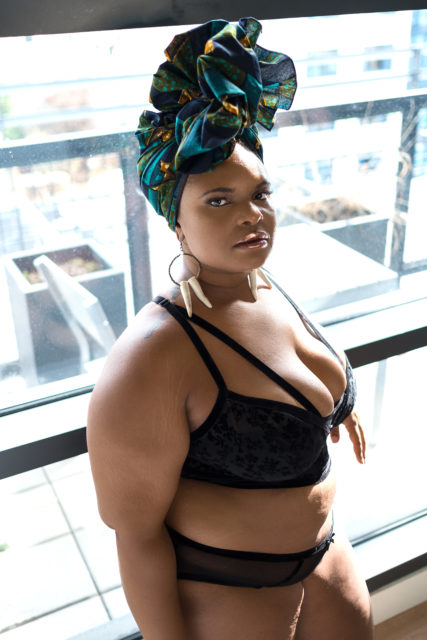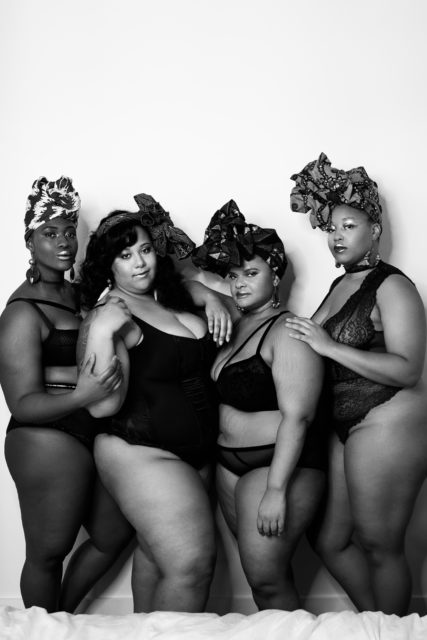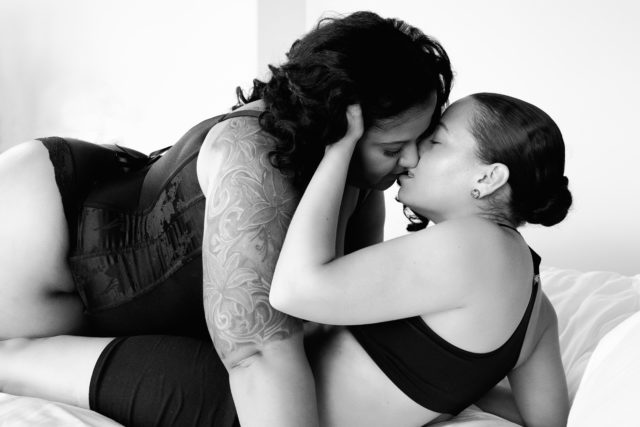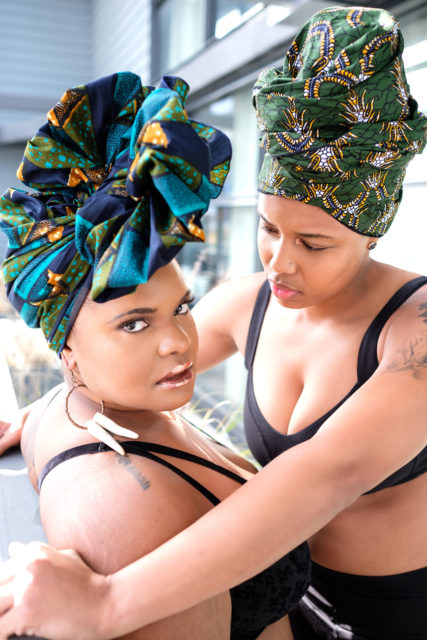Welcome to Seven Minutes in Heaven, GO Magazine’s interview series that profiles a different queer babe each day, by asking them seven unique (and sometimes random) questions. Get to know the thoughts, feelings, and opinions of the groundbreaking, fierce forces-of-nature in the queer community.

When I first saw the photos from Black Queer Goddess Project, I was so moved. These stunning shots show how empowered our queer community is — and it also proves how vital QTPOC visual representation is. Tina Colleen is the Creative Director behind the project, and she also was a model for the shoot. Colleen had a vision for this shoot, which she describes as a part of her healing process, and photographer Amanda Clare helped her reify it.
Get to know Colleen below in our Seven Minutes in Heaven.
GO: Who are you and what kind of energy do you like putting out in the world?
Tina Colleen: My name is Tina Colleen. I am a writer, poet, activist, and I work in higher education. I am a black plus-size queer cis-female and the Creative Director of the Black Queer Goddess Project: The Plus-Size Femme.
The energy I like putting out into the world is truth and positivity. It is so critical for people to walk in their truth. We have to do the work internally to understand our truths. That’s what I did with this photo series. The project was a result of shame that I have always felt. The shame of my plus-size body, the shame of still being single in my thirties, the shame of not feeling desirable or included. I decided to use the negativity I was feeling and channel it into something positive.
GO: What is the driving force behind your photography?
TC: I wish I was a photographer! I am always the Director and/or Producer of my projects. For this photo series, I created the entire vision and brought everyone together. Amanda Clare (IG: @thedivulgeproject) was the photographer and brought my concept to life.
The driving force behind my projects is the search to healing myself. I created this photo series to continue down the path to loving myself, as I am, in the present moment.
My next project is the “I Identify as Me” Project. It will be a documentary and photo series celebrating queer-trans people of color (QTPOC) that identify as androgynous women, genderqueer and agender people. These are the women/people I usually date. Their internal and external struggles have impacted me to evolve into who I am today. Additionally, I’m very passionate about advocating for people. The fluidity and layers of these women/people are so paramount and should be admired. My passion and love for them also drives me with this new endeavor.

GO: Where do you go for inspiration when you’re feeling discouraged or depleted?
TC: When I feel depleted or discouraged I try to attend a hot yoga class, re-read books from one of my favorite authors Pema Chödrön, and/or watch Netflix with a glass of wine.
Sometimes just doing nothing and spending time with myself really helps to re-charge my inspiration. Self-care is very important to me. I cannot provide the world with love and kindness if I cannot first give it to myself. I am an extroverted-introvert; I’m social, but I need alone time. I try my hardest to spend time with myself at least one day a week to unplug away from creative work and my full-time job, to avoid feeling this way.
GO: Why is it important to have images where Black queer folx can see themselves represented?
TC: Representation is how people identify normalization. If we do not see ourselves then we feel as if something may be wrong with us or we are unimportant. Everyone should feel like they are accepted. When I look at images of people in the LGBTQ+ I seldom see representation of myself. When I did see representation, it was not always healthy; either we are fetishized and/or depicted as the “best friend.” We are rarely represented as desirable enough to be relationship material.
Including couples within the photo series was intentional to portray black plus-size queer women as desirable and sensual without encouraging fetishism. Additionally, Lovia Delva who identifies as androgynous and Tatiana Cruz who identifies as no-label are slimmer than their partners; that representation was also deliberate. I wanted to challenge people’s way of thinking, show them that plus-size QWOC can be desired by slimmer women and that this type of couple looks beautiful together!
I have had many women of all races reach out to thank me for creating the photo series. One woman told me after she saw the photo series she bought herself lingerie, took a selfie and posted it on Instagram. She told me it received the most “likes” she ever received on her page. That is why representation is so vital, powerful, and desperately needed. It allows people to live in their truths and to feel like they belong.

GO: What does femme mean to you?
TC: When I think of the word “femme,” it just means that I present myself in a societal feminine manner. I do not necessarily relate the word “femme” to always being feminine and I feel that is what confuses people.
Society wants to put everyone in a box with a label and we are told we should not deviate from that box/label. This is especially relevant for QTPOC. We have been negatively impacted by Eurocentric notions because people of color are usually born outside of these standards. Unfortunately, at times, QTPOC have the unconscious desire to meet these standards to feel a part of society, but at the expense of who they are all together. As a result, gender/gender roles have become such a taboo discussion for QTPOC.
GO: Who are your queer role models?
TC: Monick Monell with TUV Magazine, Rejected Society clothing and various LGBTQ+ organizations. I admire Monick because she is a very kind and giving person. She is always looking for ways to help QTPOC achieve their goals. Additionally, Monick primarily works with LGBTQ+ elderly. The elderly are often forgotten, knowing the good work Monick does every day, gives me so much hope for mankind.
My second queer role model is Shannon Matesky, the founder of Queer Abstract. Shannon is such a force of nature! Shannon took it upon herself to create representation and a platform for artists who are QTPOC. She ensures it happens every third Friday of the month, even if she is not in New York. This platform allows performers the chance to be who they truly are in a safe space, where they are loved and cherished. Shannon always shares her struggles; that courage has also inspired me to be more proactive in creating work that celebrates QTPOC.
Both of these powerful women took a chance on me when they knew nothing about me, and lent a helping hand without asking for anything in return. Without their assistance, the photo series may not have happened.

GO: Where can people find you?
TC: People can reach me on Instagram @tinac_productions, on Facebook “Fat Black Queer Femme” or email me at TinaColleen18@gmail.com.
Models | Couples
Tina Colleen (@tinac_productions) and Lovia Delva (@nomadkreyol1)
Tatiana Cruz (@_twinns_hotmami_) and Victoria Saint-Lôt (her_twinnytwinntwinn)
Romaine Kelly (@rkellz89) and Oskar Sinclair (@dammit_oskar)
Photographer: Amanda Clare (@thedivulgeproject)
MUA: Iventt Gonzalez (@iventtglam)
Hairstylist: Helene Marie (@helene.marie)
Headwraps: Cee Cee’s Closet (@ceeceesclosetnyc)
Earrings: And And NYC (@andandnyc)

What Do You Think?